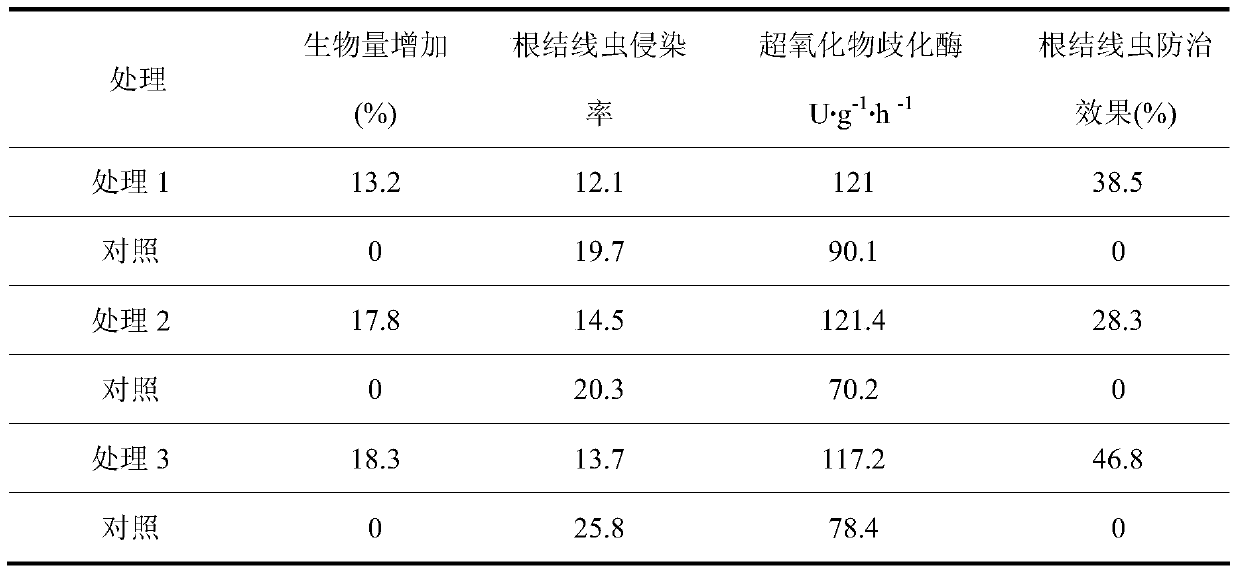A cultivation method for improving root-knot nematode resistance of northern facility tomato
A technology of anti-root-knot nematode and cultivation method, which is applied in the field of improving the cultivation of tomatoes in northern facilities against root-knot nematode, and can solve the problem that the effect of mycorrhizal fungi is not very prominent, mycorrhizal fungi cannot be directly cultured in vitro, and mycorrhizal fungi are independent To improve the anti-infection ability, improve the micro-ecological environment of the rhizosphere, and reduce the damage of pathogenic microorganisms
- Summary
- Abstract
- Description
- Claims
- Application Information
AI Technical Summary
Problems solved by technology
Method used
Image
Examples
Embodiment 1
[0022] 1. Preparation of tomato seedling substrate: Take 3 parts of rice husk and 2 parts of fermented chicken manure according to the volume ratio (preparation by composting fermentation method: in a place with good ventilation and high terrain, pile up chicken manure with litter and use it outside. The mud is closed; the fermentation time is about 15 days in summer and about 50 days in winter), 2 parts of river sand with a particle size of 1 mm and 1 part of perlite with a particle size of 1 mm (rice husk: fermented chicken manure: river sand: perlite = 3:2:2:1), mix evenly to form a mixture, and then sterilize the mixture at 121°C for 50 minutes, take it out and cool it to 40°C to prepare a seedling-raising substrate, and set it aside.
[0023] 2. The preparation method of the solid inoculum of Glomus mosesi: take the river sand passed through a 2mm sieve as the substrate, after high-temperature sterilization (121°C high-pressure steam sterilization for 45 minutes each time)...
Embodiment 2
[0031] 1. Preparation of tomato seedling substrate: Take 2 parts of rice husk, 1 part of fermented chicken manure, 1 part of river sand with a particle size of 1 mm and 1 part of perlite with a particle size of 1 mm according to the volume ratio (rice husk: fermented chicken manure: River sand: perlite=2:1:1:1), mix evenly to form a mixture, then sterilize the mixture at 121°C for 40 minutes, take it out and cool it to 30°C to prepare a seedling-raising substrate, and set aside.
[0032] 2. The preparation method of the solid bacterial agent of Glomus mosesi: take the river sand passed through a 2mm sieve as the substrate, after high-temperature sterilization (121°C high-pressure steam sterilization for 45 minutes each time), place it in a natural state for 14 days, and then pack it in two 1 kg into a pot, inoculated with 100 g of the original species of Glomus moses, mix well, add 20% of the weight of the substrate in tap water, sow the seeds of sorghum and scallions, keep nor...
Embodiment 3
[0038] 1. Preparation of tomato seedling substrate: Take 4 parts of rice husk, 3 parts of fermented chicken manure, 1 part of river sand with a particle size of 1 mm and 1 part of perlite with a particle size of 1 mm according to the volume ratio (rice husk: fermented chicken manure: River sand: perlite=4:3:1:1), mix well to form a mixture, then sterilize the mixture at 121°C for 40 minutes, take it out and cool it to 30°C to prepare a seedling-raising substrate, and set aside.
[0039] 2. The preparation method of Glomus moses solid inoculum: take the river sand passing through a 2mm sieve as the substrate, after high-temperature sterilization (121°C high-pressure steam sterilization for 45min each time), place it in a natural state for 10 days, and then take two 1 kg into a pot, inoculate 150g of Glomus moses original species, mix well, add tap water with 18% of substrate weight, sow sorghum seeds, keep normal growth, and get the host infected by Glomus moses after six months...
PUM
 Login to View More
Login to View More Abstract
Description
Claims
Application Information
 Login to View More
Login to View More - R&D
- Intellectual Property
- Life Sciences
- Materials
- Tech Scout
- Unparalleled Data Quality
- Higher Quality Content
- 60% Fewer Hallucinations
Browse by: Latest US Patents, China's latest patents, Technical Efficacy Thesaurus, Application Domain, Technology Topic, Popular Technical Reports.
© 2025 PatSnap. All rights reserved.Legal|Privacy policy|Modern Slavery Act Transparency Statement|Sitemap|About US| Contact US: help@patsnap.com

